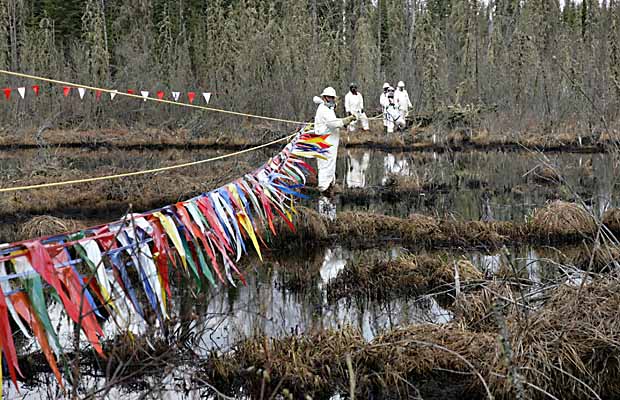EDMONTON – The 28,000 barrels of crude oil spilled into a wetland near Peace River will likely take years to clean up, especially if oil soaks into the subsoil or groundwater, said a managing director of the Pembina Institute, an Alberta-based energy and environment think tank.
“One big spring snow storm or rainfall and we could be facing a large contamination issue, and that’s normal weather for that region,” Chris Severson-Baker said. “I wouldn’t be surprised if clean up takes more than a year or two. There will be a lot of soil and vegetation that will be saturated with oil.”
The worst Alberta spill in 35 years happened on the Rainbow pipeline, which runs 770 kilometres from Zama to Edmonton. The pipeline, built in 1966, ruptured previously in 2006, when it was run by a different company. That time, 7,840 barrels of oil leaked into a creek south of Slave Lake.
When the Energy Resources Conservation Board issued a report on the spill in May 2007, workers were still trying to remove all of the contaminated soil and water.
The company was told to reduce the pressure in the pipeline by 20 per cent until it checked out 22 other sites identified as at risk.
It was also told to run two inspection devices inside the length of the pipeline to ensure there were no further weaknesses in the metal, and to fly the length of the pipeline with an airplane twice a week to watch for small leaks. Those conditions, applicable only on the southern portion of the line, were lifted in March 2010, said board spokesman Davis Sheremata. They never applied to the northern portion of the line, where last week’s leak occurred.
Corrosion on the outside of the pipe caused the 2006 rupture. Officials still haven’t determined what caused this most recent break.
The portion that leaked is now being tested by an engineering firm in Edmonton. Sheremata said it’s important to determine if the piece of pipe broke because of the overall integrity of the line or if it was a problem only with that particular spot. Even if the latter was the case, the board will have to look at the whole line to be certain it won’t fail elsewhere when it is allowed to resume operations, he said.
Stephen Bart, vice-president of operations for Plains Midstream, could not say how much oil was running through the pipeline when it broke. Nor could he say whether the section in question had ever been replaced or refurbished.
Severson-Baker said the most recent spill highlights the need for the ERCB to take an active role in deciding how long Alberta’s aging pipelines should continue to operate.
“I don’t think it’s fair to say you can keep them running forever,” he said. “This is the second time this pipeline has had this problem. More can and should be done.”
Brenda Kenny, president of the Canadian Energy Pipelines Association, said most of Alberta’s pipeline right-of-ways include pipeline buried before 1950.
But she said it can still be safe if properly maintained. Techniques used to protect metal against corrosion have always been used. “It’s the same reason why iron bridges don’t rust,” she said. “As far as we know, there is no reason why a pipeline can’t be used a very, very long time.”
The number of pipeline breaks dropped 50 per cent in the last 15 years, mainly because of new devices that run through the inside of the pipe and scan the walls for weaknesses.
The Rainbow pipeline was scanned once a year. When information is available on what caused the Peace River rupture, Kenny said, the association will help its members upgrade safety practices to take that into account.
Premier Ed Stelmach has argued Alberta needs to develop new markets, which includes building pipelines to the West Coast and a new one through the central United States.
The recent spills will have an impact on residents evaluating the risks of letting oil companies run pipes across their land, said Severson-Baker. “If we in Alberta are going to be very convincing, we have to demonstrate that we have a very robust system to manage pipelines in Alberta.”
Stelmach called the spill “disappointing,” but said he has confidence in the ERCB’s ability to monitor the clean up and ensure pipeline safety across the province.
Alberta’s aging pipeline system is challenging for the industry, but the application of new technology is mitigating that risk, he said. “New technology, new materials – there is so much improvement in pipeline construction and monitoring.”
The spill will likely affect discussions about a new pipeline to the coast, Stelmach said, “but overall I do know that the world needs energy. We are going to get that energy to them, and as far as I’m concerned the ERCB is doing an excellent job.
“Our rules and regulations are stricter than in many other jurisdictions around the world, and so I have great confidence in … the pipelines.”
William Whitehead, chief of the Woodland Cree, owns a trapline that crosses the contaminated wetland.
“That’s the main stream; it’s a little creek there,” he said. “Good thing they had that beaver dam on there, eh? If they wouldn’t have had that beaver dam, God knows where that oil would have flowed. Probably down to Lubicon Lake. It’s not far from there.”
The area around Lubicon Lake has been set aside by the province as the future reserve of the Lubicon Lake First Nation, if their 40-year-old land claim is ever settled.
Whitehead called on the companies involved to attend a community meeting in Marten Lake, a tiny community that is even closer to the spill than Little Buffalo.
“They should come to the community and have a meeting with the people. Let them know what they’re going to do,” Whitehead said. “Then they would feel secure.”
Edmonton Journal




Comments